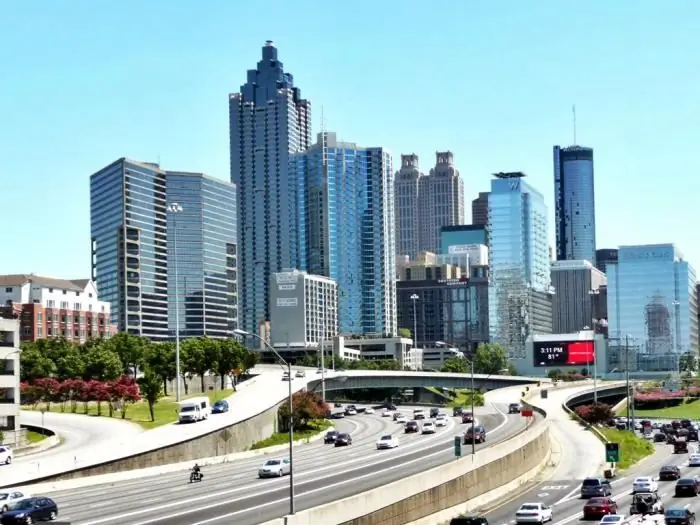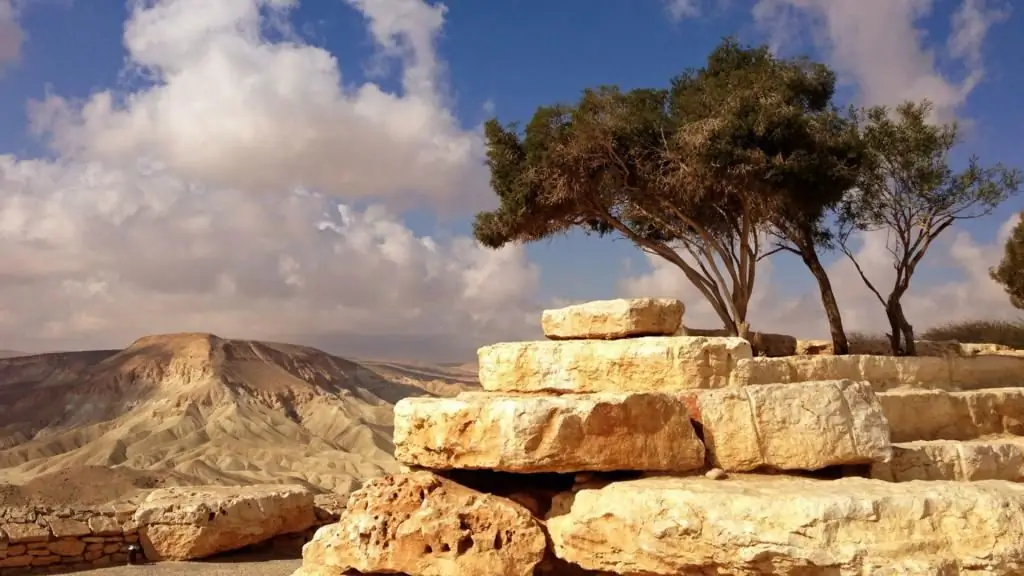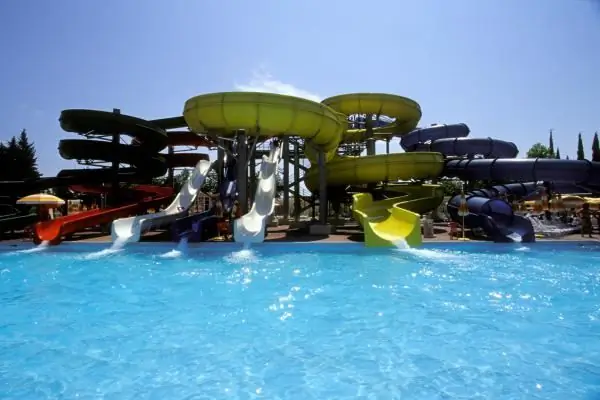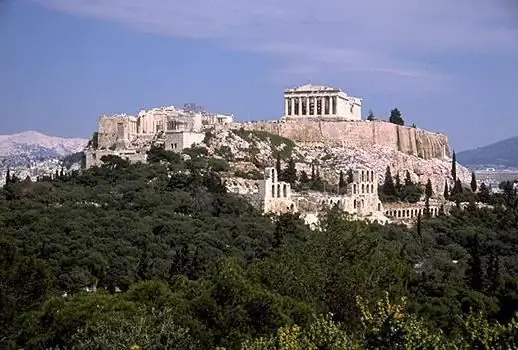- Author Harold Hamphrey [email protected].
- Public 2023-12-17 10:06.
- Last modified 2025-01-24 11:10.
"Red City" - this is how the name of the capital of Mari El is translated from the Mari. All those who happened to visit here quite recently do not hide their surprise and the impressions that Yoshkar-Ola made on them. The sights here are really unusual, many of them appeared quite recently.

From the past
The history of Yoshkar-Ola began in that distant time, when the Mari land was annexed to Russia after the defeat of the Kazan Khanate by the army of Ivan the Terrible in the middle of the 16th century. The city of Tsarev on the Kokshaga River, or Tsarevokokshaysk, was first mentioned in the chronicles in 1584, although, according to archaeologists, people already inhabited these lands in the Mesolithic era.
The city began with a fortress built to protect the lands and performing exclusively military functions. He ruled the fortress of the governor, in whose hands not only military, but also administrative, fiscal and judicial power was concentrated. Gradually, they began to appearmerchants, artisans, peasants who usually settled not in the city itself, but occupied the land around it. This is how the settlement, settlements and villages were formed.
Our time
Modern Yoshkar-Ola was formed in the period from 1941 to 1990 and continues to be built up to this day. Its appearance has changed especially over the past 10 years, after the development program of the city "Capital" was approved.

A renewed city with a rich past and a major center of Finno-Ugric culture - this is how modern Yoshkar-Ola appears before us. Sights that must be seen are cultural, historical and architectural monuments, reflecting different periods of the region's development. Among them are ancient estates, churches, historical buildings, squares, as well as numerous sculptural compositions. Theaters and museums play an important role in the cultural life of the capital city of Mari El.
Theatres
The eventful theatrical life of Yoshkar-Ola is represented by all classical types of theatrical art.
In 1968, as a result of the transformation of the United Drama Theater. Mayorov-Shketan Music and Drama Theater was founded. In 1994 it was renamed. This is how the Mari State Opera and Ballet Theater named after M. Erika Sapaev, named after the Mari Soviet composer, author of the first national opera. It was based on graduates of choreographic schools and conservatories in Moscow, Leningrad, Kazan, Perm, Gorky. Thus began the formation of a young theater and nationalperforming school. About 50 classical and modern works of ballet, opera and operetta art, as well as children's performances were staged on its stage.

Today the repertoire includes the national operas "Aldiar" by E. Arkhipova, "Akpatyr" by E. Sapaev, the ballet "Forest Legend" by composer A. Luppov. The pride of the theater is choreographic productions: the ballet The Nutcracker and Swan Lake by Tchaikovsky, Romeo and Juliet by Prokofiev, Don Quixote by Minkus. For 11 years, the theater has been hosting the international festival "Winter Evenings" with the participation of opera and ballet dancers from Russia, Italy, Japan, and America. In 2002, the only festival in the world dedicated to the great ballerina Galina Ulanova began to be held here. The theater successfully tours not only in Russia, but also abroad. These are China, United Arab Emirates, Germany, South Korea, Central America, Taiwan, Lebanon and other countries. Today the theater occupies a new building, built not so long ago especially for it. In terms of equipment, it is considered the best in the Volga region.
Mari National Drama Theatre. Shketan, which is the oldest in the republic, began its history with an amateur production in November 1919. Since 1929 it has been a professional cultural institution, which later became one of the best in Russia. The theater actively participates in the world theatrical life, while maintaining its national identity. Of the awards, he was awarded the "Golden Palm" - the prize of the Association of Theaters of Europe.

The Academic Russian Drama Theater named after G. Konstantinov, founded in 1919, operates in the capital of Mari El. Many directors have contributed to its development. The most important role belongs to the chief director Grigory Konstantinov, who held this position from 1964 to 1994. On his initiative, the International Association of Russian Theaters was established in 1993, with headquarters in Yoshkar-Ola. In September 1994, the theater was named after Konstantinov. Performances based on the works of classics and contemporaries are staged on the stage of the Russian Drama Theater. Among the best are Shakespeare's Othello, A. K. Tolstoy's Tsar Fyodor Ioanovich, Rozov's Capercaillie's Nest, Ostrovsky's Mad Money, Gorky's Petty Bourgeois, Pavlova's Conscience.
In 1991, in Yoshkar-Ola, on the basis of the Russian Drama Theater named after Konstantinov, the Mari Theater of the Young Spectator was opened. Now he has in his repertoire 35 productions based on the works of national, Russian, foreign classics and modern dramaturgy. For all the time, more than 80 performances for children and adults in the Mari and Russian languages were staged on its stage. The theater troupe constantly goes on tour in Russia and abroad.
Museums
History, culture, traditions and way of life of the Mari people are reflected in the collections of various museums in Yoshkar-Ola.

The Museum of the History of the city of Yoshkar-Ola has in its collections objects of archeology, heraldry, ethnography, works of fine and appliedart, photography. It is housed in a two-story red brick house built in 1911 in the city center. This house, now declared a historical and architectural monument of republican significance, belonged to the well-known local timber merchant Chulkov. The former merchant's estate consists of the main building, an outbuilding and stone gates, which are decorated with Art Nouveau elements. The permanent exhibition presents the history of Yoshkar-Ola from 1584 to 1917. Visitors will learn about the emergence of the fortress city of Tsareva, how it was built, about its development, the life and traditions of the townspeople, and the fate of famous people. Thematic exhibitions are held here every season. Currently, the Museum of the History of the City of Yoshkar-Ola invites you to the photo exhibition "City and Time". On unique photographs you can see what Yoshkar-Ola was like in different years of the last century. Temporary exhibitions reflect the life of a modern city, introduce businesses, the history of streets, the creativity of citizens, and charity events.
The Museum of Folk Applied Art was opened to visitors in 1999 in a building declared a cultural value of the Republic of Mari El.

This carved wood house was built in the early 20th century. Before the revolution, it was owned by the contractor of the zemstvo council Lokhanov. The museum introduces folk crafts, history and life of the Mari people. In total, about 250 exhibits were collected, including ethnographic items, examples of fine arts and arts and crafts. Here you can seenational costumes with embroidery, wicker furniture, carved ladles, musical instruments made by folk craftsmen. The Museum of Folk and Applied Arts organizes annual festivals and exhibitions.
In 1961, on the occasion of the anniversary of the first Mari composer, who became the founder of professional national music, the Memorial Museum of I. S. Klyuchnikov-Palantai was opened. It is located in a wooden house where the composer lived in recent years. The exposition is located in three rooms, which recreate the home environment of representatives of the provincial intelligentsia of the early 20th century. Authentic household items, furniture, manuscripts and other belongings of the Palantai family members have been preserved here. The museum hosts exhibitions, music evenings, lectures, meetings with composers.

Art museums and exhibitions
The Museum of Fine Arts of the Republic of Mari El, which was established in 1989, operates in several directions. It is located in a building designed by architect V. Babenko in 1980. In addition to the works of the Mari fine arts and applied arts, Russian painting, sculpture, graphics, as well as single works of Western European painters and graphic artists are presented here. The museum holds public lectures, where you can get acquainted with the history of arts, with the world artistic culture, the history of creativity of the Mari people. Its funds contain more than 7 thousand units of storage. The museum presents paintings by Russian artists of the 19th century(Serov, Shishkin, Makovsky, Egorov). The works of modern Finno-Ugric fine art in the genre of ethnosymbolism and ethnofuturism attract attention. These are paintings by Mari artists - A. Ivanov, S. Evdokimov, V. Bogolyubov, I. Efimov. In addition to the permanent exhibition, the museum offers thematic exhibitions, which are regularly updated.
The National Art Gallery is the main exhibition area of the capital. It was founded in 2007 as a branch of the Museum of Fine Arts. The gallery is located on the main square of Yoshkar-Ola. It has the most modern equipment: climate control, video surveillance and fire extinguishing systems, special lighting, burglar alarms, mobile exposition equipment. The gallery has an active exhibition activity.

Visitors get acquainted with the work of Mari and Russian artists, masters of fine arts of the Volga republics, as well as collections of Russian museums. World-class exhibitions are held here. During the years of the gallery's operation, residents of Mari El had the opportunity to see the works of Edgar Degas, Salvador Dali, Ilya Glazunov, Nikas Safronov, Benoit de Stetto. Collections of the largest Russian museums were exhibited on the site: the Tretyakov Gallery, the Zlatoust Museum of Weapons, the Amber Museum (Kaliningrad). The following exhibitions were most successful:
- "Return. From Europe to Russia” by Benoit de Stetto.
- "Faces of time" - about the culture of the Mari region.
- Solo exhibitionartist Nikas Safronov.
- Photo exhibition "Private Collection" by E. Rozhdestvenskaya.
- "Gold of the B altic" - from the funds of the Amber Museum in Kaliningrad.
After the opening of the virtual branch of the State Russian Museum in the gallery, residents of Yoshkar-Ola can get acquainted with the masterpieces of fine art from the largest museum in the northern capital at home.
Monuments of history and architecture
Objects of historical, architectural and cultural value are usually located in the historic district of the city. Unfortunately, few pre-revolutionary buildings have survived in Yoshkar-Ola. Among them are merchant houses:
- Chulkov's House (late 19th century), which houses the Museum of the History of the City of Yoshkar-Ola.
- Manor of the merchant Pchelin (18th century).
- Karelin House (mid-18th century).
- Bulygin House (mid-19th century).
- Naumov's house with decorative carvings along with wooden buildings (19-20th century). This is one of the most beautiful buildings in the old city.
Temples
Unfortunately, almost all 18th century churches were completely or partially destroyed during the Soviet period. Today there are temples in the city that have been reconstructed or rebuilt. Among them:
- Trinity Church was the first stone building and one of the oldest in the city (1736). Funds for the construction were provided by the merchant Vishnyakov and the peasant Osokin. It was a traditional two-story building, consisting of a large quadruple with a refectory. Chetverik was crowned with five domes, at the bottom wasNikolsky chapel, a multi-tiered bell tower stood separately. In the 30s the church was closed, the bell tower and the upper tier were destroyed. It began to be restored according to a new project in 1995 and was completed only in 2008. The new building retained the forms characteristic of church architecture of the 18th century. It has become one of the most beautiful buildings in the city. The temple is connected to the bell tower by an arch, and its bizarre roof is crowned with five gilded domes.
- The Ascension Cathedral was built at the expense of the merchant Pchelin in 1756. It was an octagon on a quadrangle with bypass galleries, a large refectory and a separate bell tower in several tiers. The church closed in 1937, was partially destroyed and rebuilt, then a brewery was placed in it. In 1992, the temple was returned to believers and restored. Since 1993, the cathedral has had the status of a cathedral.
- The Cathedral of the Resurrection of Christ with Moscow baroque decor was originally built in 1759. It was a one-light quadruple with two octals decreasing in width. The four-tiered bell tower was built in the late 18th and early 19th centuries. The refectory and two aisles (Fedora Stratilata and Pokrovsky) were built at the end of the 19th century. In 1928 the church was closed, the upper octagon and the bell tower were destroyed. Only in 1944 the building was returned to believers, but in 1961 the cathedral was closed again and completely destroyed. Only in 2008 the construction of a new temple began, which continued until 2010. The renovated Cathedral of the Resurrection of Christ, built in the 18th century baroque style, was consecrated in 2010year.

- The Church of the Assumption of the Blessed Virgin was founded in 2005 as an Orthodox church. The building, in a style close to the New Byzantine, was built in 2005-2006.
- The Church of the Icon of the Mother of God of Tikhvin was built in 1774 (according to it, in which the St. in the 90s and reconstructed. Today, a park has been laid out on the site of the cemetery.
Monuments
There are many different monuments in Yoshkar-Ola, against which guests like to be photographed, and the residents of the city themselves. Among the best known:

- The Tree of Life sculpture, located in the Park of Culture and Leisure, reflects the national flavor of the Mari region. The monument, the author of which is the artist Andrey Kovalchuk, was installed in 2008. In the center of the composition is a tree, symbolizing life and continuity of generations, and around it are three bronze musicians belonging to different generations, with national instruments in their hands. The old man plays the flute, the man plays the harp, the boy plays the drum. The three-meter-high monument occupies a good place in the park, where it can be clearly seen from everywhere.
- The monument to Obolensky-Nogotkov - the founder of the city, the first governor - is installed on the square of the same name opposite the government building. The six-meter-high monument is considered a symbol of Yoshkar-Ola and one of its main attractions. Prince Obolensky-Nogotkov is depicted on horseback and with weapons in his hands. The monument was created according to the sketches of the sculptor A. Kovalchuk in 2007.

- A bronze monument was erected on the square near the railway station to the famous Mari Soviet actor and poet. Yivan Kyrla is depicted sitting on a trolley, as it was in the movie "A ticket to life", where he played the role of Mustafa, the leader of homeless children.
- The copy of the Tsar Cannon was made in 2007. This is a half-sized copy of the famous original, which was cast in bronze by A. Chokhov in 1586. The Mari cannon, which weighs 12 tons together with the cannonballs, was manufactured at the Zvenigovsky plant named after. Butyakova. According to the masters, she can shoot. For this reason, a core is welded into her barrel.

Unusual sights
Many people are surprised by modern Yoshkar-Ola. The sights here are incredible, even strange.
One of them is a monument to the hammer, which was installed in 2008 on the alley opposite the office building of a construction company. A four-meter metal hammer weighing two and a half tons hammers a nail into the ground. The author of the idea - the president of this construction company - decided in this way to perpetuate the work of the workers and pay tribute to them. A little later, next to the hammer, a monument appeared to the worker himself in the clothes of a builder with a brick in his hand.

Before enteringIn the same building, not far from the monument to the hammer, there are two more original sights - a blue elephant about 1.5 m high and a huge chair.
There is a rather strange bronze sculpture in the city center near the main university building. This is a monument to Yoshkin the cat, which was installed in 2011. The authors of the composition are A. Shirnin and S. Yandubaev, the sculpture was cast in Kazan, at the expense of a Moscow businessman. In 2013, not far from Yoshka's cat, lounging on a bench, a monument to Yoshka's cat appeared, the installation of which was timed to coincide with the opening of the cafe of the same name.
New architecture of the capital
Over the past few years, the face of the city has changed dramatically. Construction is underway here, the scale of which is simply amazing. Buildings in various European architectural styles sprang up right before our eyes. New streets and squares with amazing buildings seem fabulous, playful and a bit like scenery.
Unusual attractions, no doubt, include the Bruges embankment, which was named after the city in Belgium. When you get to this street, you involuntarily think that you are in the European city of Bruges. The embankment is completely built up with buildings of the Flemish style, typical for medieval Flanders. It is especially beautiful here at night, when the backlight is turned on.

The guests note that Yoshkar-Ola presented a grandiose surprise, turning from a boring Soviet center of autonomy into an interesting city where you want to return. Many people say that the architecture is controversial, but almost everyone agrees that it is unusual, memorable, positive.
The Annunciation Tower with chimes is of particular surprise to tourists. This is a reduced copy of the Spasskaya Tower in Moscow. Many guests simply fall into a stupor when the chimes suddenly ring out, and exactly the same as in the Russian capital.
Despite the fact that Yoshkar-Ola is compact, its sights are varied and numerous. Everyone who has visited this wonderful city with glorious traditions will have something to remember and tell their friends about.






